Fantastic Four / 2005
| # | Title | Duration | |
|---|---|---|---|
| 1 | Main Titles | 2:34 | |
| 2 | Cosmic Storm | 4:47 | |
| 3 | Superheroes | 5:52 | |
| 4 | Experiments | 2:41 | |
| 5 | Planetarium | 1:28 | |
| 6 | Entanglement | 1:13 | |
| 7 | Power Hungry | 4:26 | |
| 8 | Changing | 2:47 | |
| 9 | Lab Rat | 4:50 | |
| 10 | Unlikely Saviors | 2:15 | |
| 11 | Bye Bye Ned | 2:16 | |
| 12 | Battling Doom | 7:02 | |
| 13 | Bon Voyage | 1:16 | |
| 14 | Fantastic Proposal | 2:21 |
Scoring Session Pictures
Pictures by Dan Goldwasser

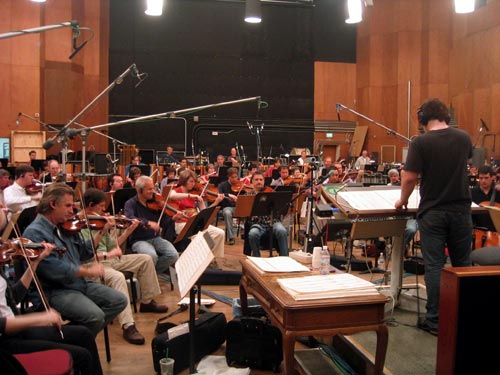
Amanda, John, and Larry in the mixing booth at Fox / Damon conducts the Hollywood Studio Symphony

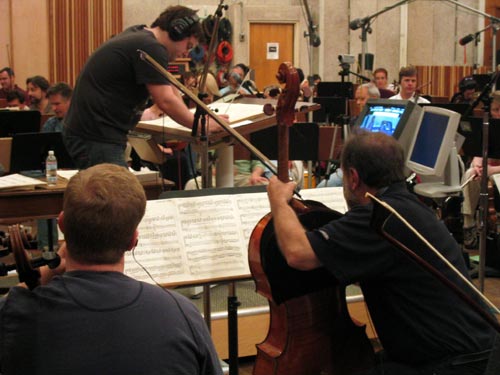
Casey at the mixing board, as John listens / Damon gives the orchestra notes
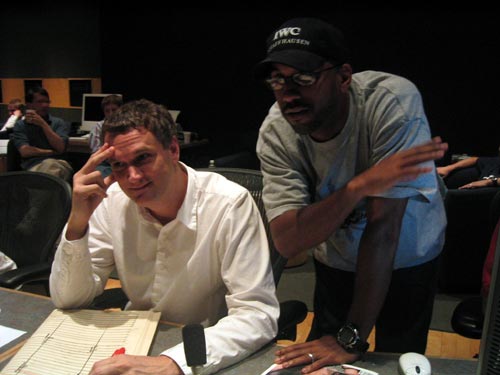
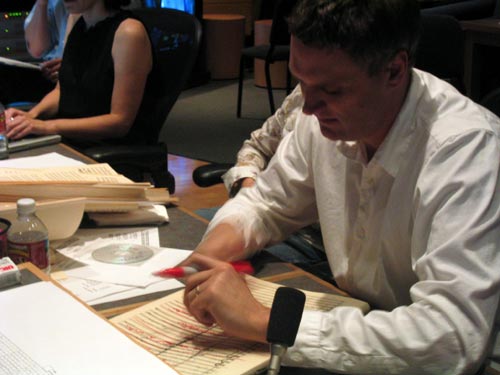
John and director Tim Story / John makes notes during a take
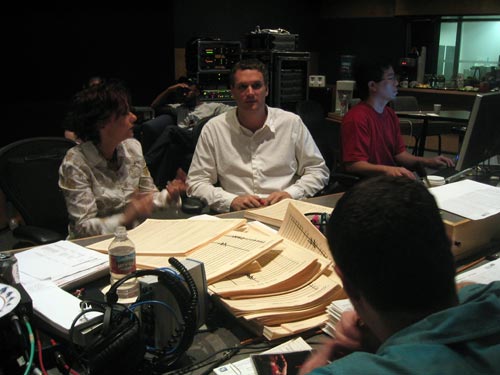
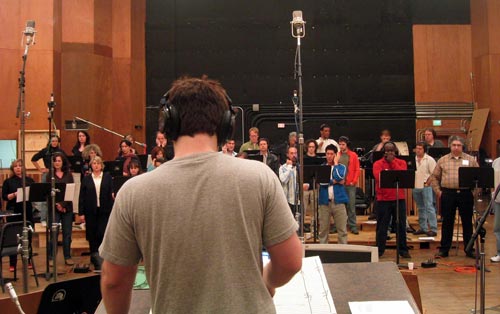
Orchestra contractor Debbi Datz-Pyle talks with John and Casey / Damon conducts the choir

The choir for Fantastic Four
John's Thoughts
I distinctly remember the moment I stumbled across the basic thematic chords for Fantastic Four. It was one of those spontaneous doodles on the keyboard that actually ended up being something worth while. I knew F4 was down the pipeline, but I was completely focusing on the film I was on, Hide and Seek. It was late one night while I was in the middle of writing a dreary cue. To break out of the monotony of the rather atonal evening, I just decided to pull up a new French Horn patch on my computer and threw my hands down to play a couple chord progressions. I got excited, but then immediately questioned whether this was just me responding to a change of pace for the evening and a new horn patch, or whether I actually had something. I tend to worry about a multitude of things at the same time, and even though I was focusing on my Hide and Seek score, I was also subliminally freaking out about coming up with a theme and score for F4. So this momentary break to play with the French horn patch was a little more than just taking a break. I think my mind needed to know that when it came time to write F4, I would have something to go on: the psychosis being that only then could I re-focus on my current project knowing everything would be ok with the next one. Weird I know. The delusion usually is that when these little ideas are jotted down and then resurrected weeks later, they're often discovered to be crap that just made me feel better at the time.
But when I opened the F4 file weeks later, I was relieved that this time these ideas were truly my brain telling me, "Hurry, get this down, I've figured something out that you didn' even realize you were thinking about." I knew I had the basis for a theme that was going to be perfect for the film. - Heroic, noble, heartfelt, human and fun all in one.
The challenge was now organizing these thoughts into a cohesive theme that I could develop. Recalling that in X2 the theme would barely get screen time in its entirety, I initially made the F4 theme short and simple, basically lacking a second movement. The centerpiece of the theme was a trumpet motif culminating in three triplets. When reading the script, I knew that the Human Torch would need a fanfare, and that it would be perfect to hear this when he combusted. I also knew this motif could be an immediately recognizable signature for the score. A theme in modernly cut films has to make an immediate impact, especially when there are often no opening title sequences to establish it. This motif would be that recognizable sound.
Over a couple days I then composed an 8 minute synth suite of my initial thematic ideas for the film, including different versions of the theme to show how malleable it could be. The heart-pounding part is when I brought the CD to the director and editor to listen to. Half way through their listening I thought to myself, "Am I crazy presenting something so long? They're probably bored out of their minds!" But it was received well with the main comment being that they actually wanted the theme to be longer as in the tradition of more classic scores. I thought, well, shit yeah. But I also knew there would be a snowball's chance in hell of the whole theme ever being played on a scene. Nevertheless, writing a full piece would be exciting, even if relegated to the end titles or the album.
Themes
The main theme really encompasses all the characters, as they all share the same fate. It develops throughout the story in many incarnations, one of my favorites being the slower romantic brass version best reflected when the witnesses on the bridge begin clapping for our heroes. Dr. Doom's theme is quite utterly a minor version of the F4 theme with metallic and percussive sounds added. Since he was once a part of the gang, I felt it made sense for him to share a theme, but turned on its head somehow. Later in the film I expanded his theme to give an even darker ominous quality with dramatic brass, low winds and choir.
Ben Grim is the only character with a full-fledged theme of his own. He's the one character who can' change back and forth, and who longs for what he was before – and for the life he had. I wanted a heartfelt Americana feel that exemplified his life as an astronaut and also provided a sense of remorse for what he left behind. So I just started with a solo trumpet and went from there.
Sue Storm and Mr. Fantastic share a love theme that I came up with when writing the suite. Thankfully, when adapting it to the picture, it worked well. It begins with a simple Celeste and piano six-note figure that repeats. This in my mind reflected Sue Storm thinking of her past with Mr. Fantastic. The Celeste motif then gets taken over by a solo flute before entering into the love theme, mainly characterized by piano and supporting light strings. Of course, when the film was re-edited after scoring it, the motif got used constantly and rarely ever got to move into the main love theme until the end of the film. This was a common occurrence for the score in the final film, in that we recorded to a different version of the film because of its tight deadline.
F4 was originally a film which breathed more. I also had to write some cues to scenes that weren' being shot until just before and during the final dub. So there would be no time to see the scenes, score them and have a scoring session in time before the final sound mix. In the end we recorded about 90 minutes of music performed by a 96 piece orchestra, and in the final abbreviated film, the score was edited down (sometimes awkwardly) to about 70. My music editor did a great job, and I kept in mind when writing that the cues would be cut down. So I tried to design them in a fashion that would allow the cues to be as "editable" as possible. The film's re-edit was so severe though, that a lot of the cues went through a Cuisinart. I don' think there was a single scene that didn' get chopped down. Just comparing, for instance, the Cosmic Storm or Battling Doom cues from the album to the scene in the film, you can hear in the music how the scenes originally had more breadth to them. But last minute CGI sequences will do that to you! It was originally planned to have a full-fledged main title sequence animated to my three minute theme. So the animators took the music and made a sequence to it. Then, two days before the final dub, it was decided to scrap the opening animated title sequence all together. So my music editor placed the tail end of the theme over the opening title cards, and this became the "opening titles." Fortunately, the piece survived mainly intact in the end titles.
Most the character motifs enabled me to weave in hints of the main theme. The Powers motif is a quirky staccato oboe supported by amorphous orchestral colors with a backdrop of strings hinting at the main theme. Sue Storm has a "feminine" motif comprised of delicately overlapping tremolo strings, glockenspiel and choir whenever she uses her powers. This motif then becomes huge later in the film when she kicks more ass. Mr. Fantastic's motif was a lot of fun to design, made up of magical overlapping clarinet and flute arpeggios offset by four-note bassoon scales. Behind these arpeggios I wrote string glissandos reflecting his stretching. The fun part of establishing these motifs was that I was able to do a medley of all these ideas in the final battle with Doom – most cohesively heard on the album.
All in all, F4 was an assignment I enjoyed greatly. Writing for full orchestra is a blast, and the world of superheroes is a fantastic musical place to be. I hope I can do this again!



